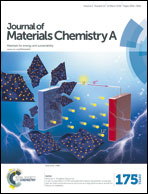Inverted all-polymer solar cells based on a quinoxaline–thiophene/naphthalene-diimide polymer blend improved by annealing†
Abstract
We have investigated the effect of thermal annealing on the photovoltaic parameters of all-polymer solar cells based on a quinoxaline–thiophene donor polymer (TQ1) and a naphthalene diimide acceptor polymer (N2200). The annealed devices show a doubled power conversion efficiency compared to non-annealed devices, due to the higher short-circuit current (Jsc) and fill factor (FF), but with a lower open circuit voltage (Voc). On the basis of the morphology—mobility examination by several scanning force microscopy techniques, and by grazing-incidence wide-angle X-ray scattering, we conclude that better charge transport is achieved by higher order and better interconnected networks of the bulk heterojunction in the annealed active layers. The annealing improves charge transport and extends the conjugation length of the polymers, which do help in charge generation and meanwhile reduce recombination. Photoluminescence, electroluminescence, and light intensity dependence measurements reveal how this morphological change affects charge generation and recombination. As a result, the Jsc and FF are significantly improved. However, the smaller band gap and the higher HOMO level of TQ1 upon annealing causes a lower Voc. The blend of an amorphous polymer TQ1, and a semi-crystalline polymer N2200, can thus be modified by thermal annealing to double the power conversion efficiency.


 Please wait while we load your content...
Please wait while we load your content...